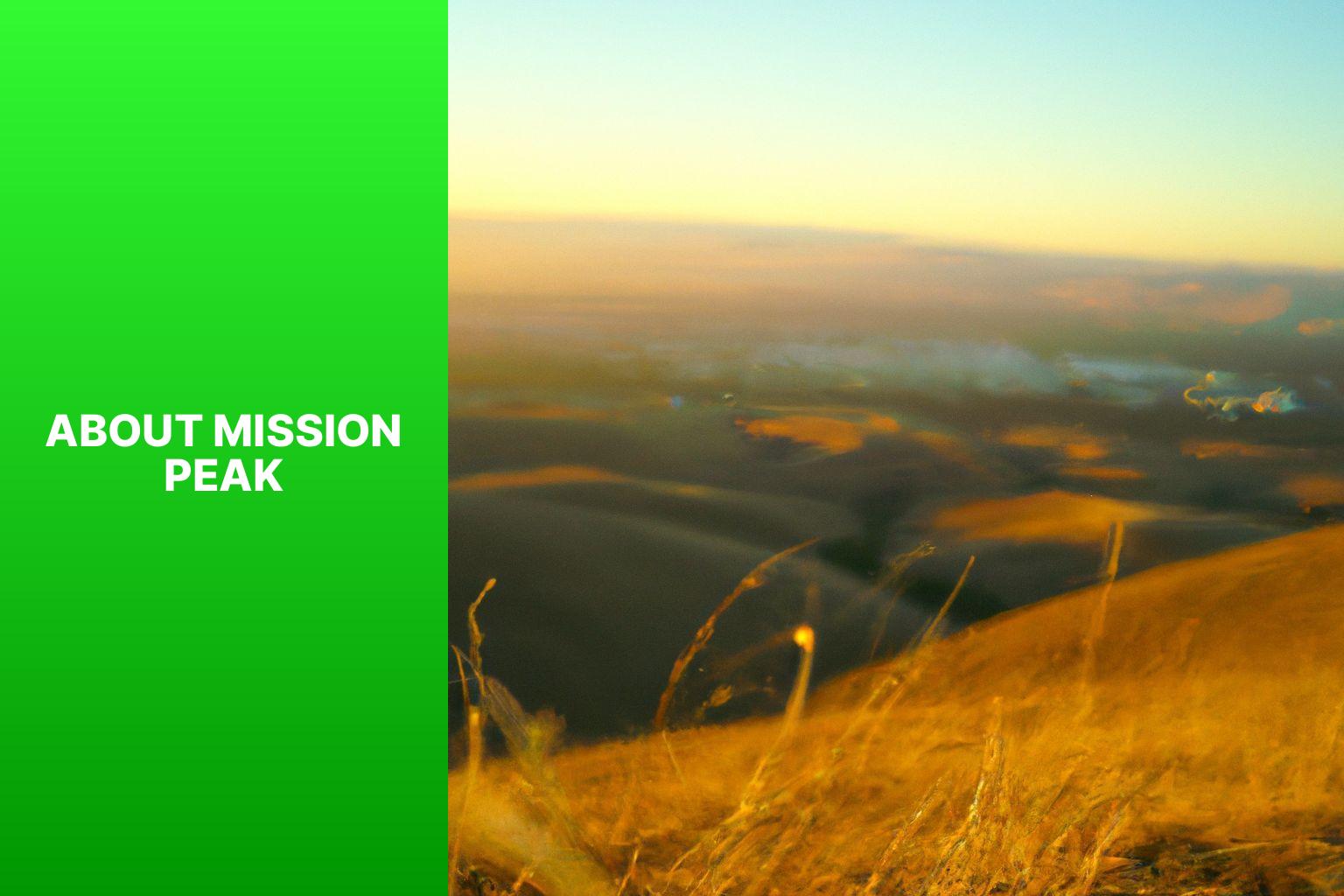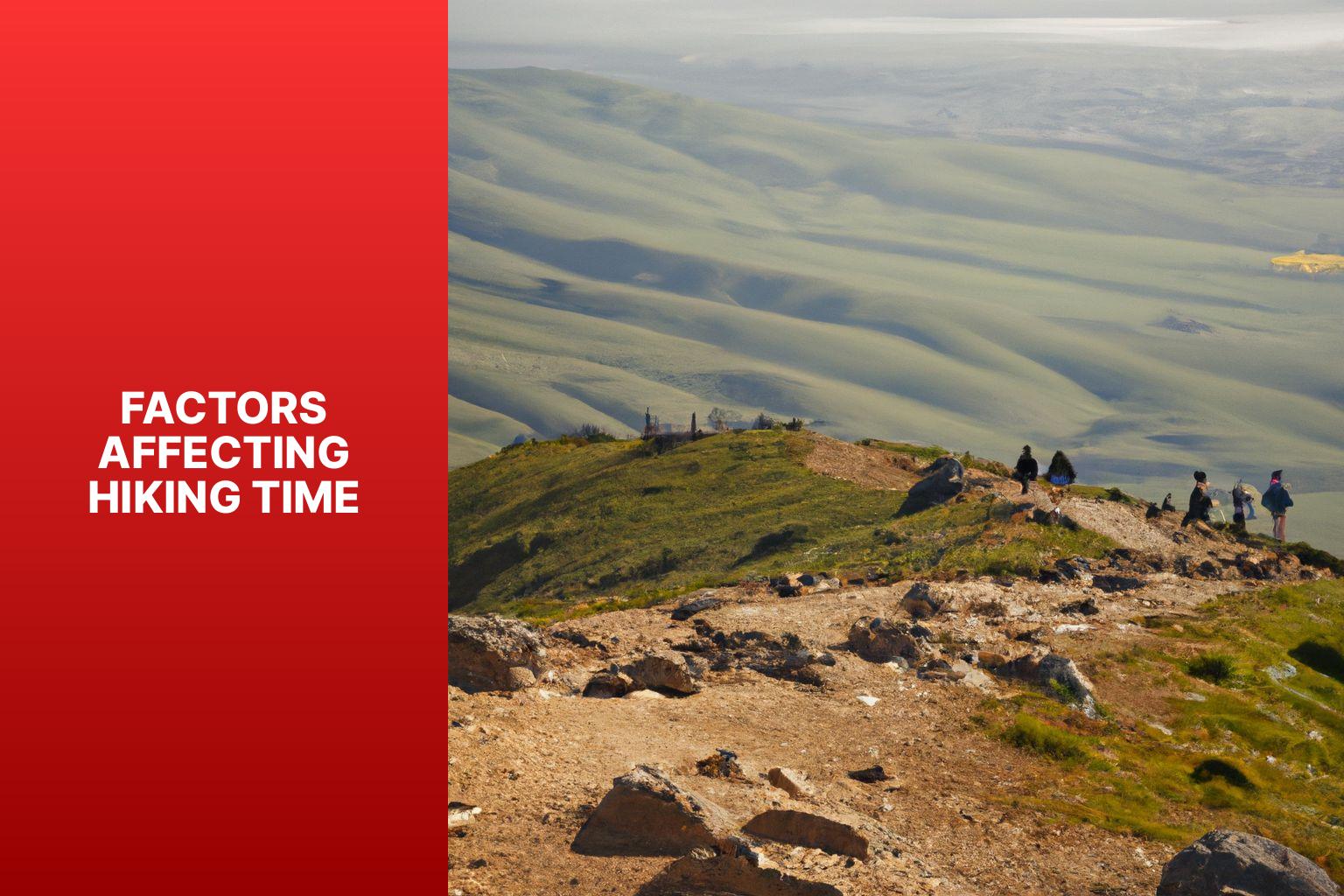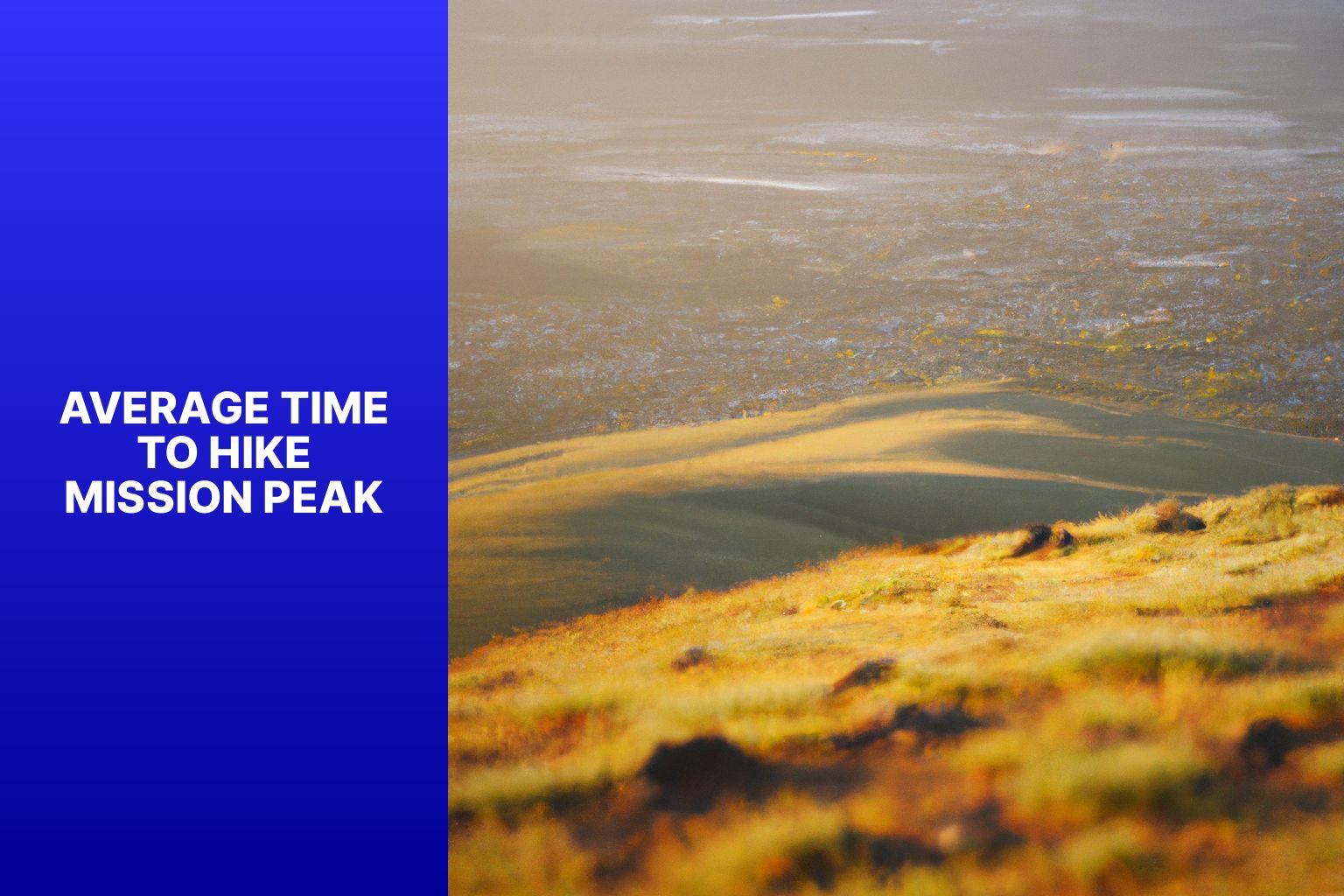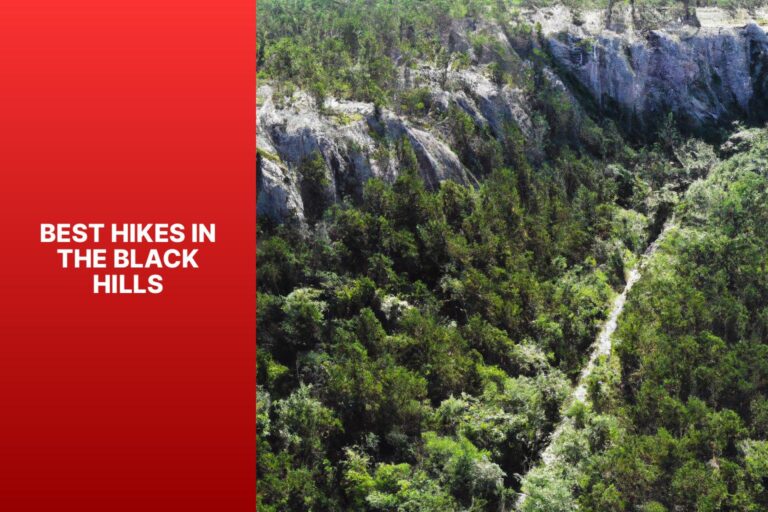How Long Does It Take to Hike Mission Peak
Mission Peak, located in California, is a popular hiking destination known for its stunning views and challenging trails. Before embarking on this hike, it is essential to understand the basics of Mission Peak. This information will help you plan and prepare for a successful hiking experience.
About Mission Peak:
Mission Peak is situated in the city of Fremont, California, and is part of the larger Mission Peak Regional Preserve. It is a prominent peak in the area, offering panoramic views of the San Francisco Bay Area.
The Elevation of Mission Peak:
Standing at an elevation of 2,517 feet (or 767 meters), Mission Peak provides a moderate-to-challenging hiking experience.
The Difficulty Level of Mission Peak Hike:
Several factors contribute to the difficulty level of the Mission Peak hike, including the terrain, distance, and elevation gain.
The Terrain:
The trail consists of a combination of paved sections, gravel paths, and steep dirt trails. It is important to be prepared for uneven surfaces and rocky sections along the way.
The Distance:
The round-trip distance to Mission Peak is approximately 6.2 miles (or 10 kilometers), making it a considerable hike that requires endurance and stamina.
The Elevation Gain:
Hikers must be prepared for an elevation gain of around 2,000 feet (or 610 meters). The steep ascent can challenge even experienced hikers.
Factors Affecting Hiking Time:
Several factors can influence the time it takes to complete the Mission Peak hike. It is important to consider these factors to plan your hike effectively.
- Fitness Level: Your physical fitness level plays a significant role in determining how long the hike will take. Regular physical exercise and cardiovascular endurance can help increase your hiking speed.
- Trail Conditions: The trail conditions, including the presence of loose rocks or slippery sections, can impact your hiking pace. It is crucial to adjust your speed accordingly to ensure safety.
- Weather: Weather conditions, such as extreme heat or cold, can affect your hiking time. It is important to check the weather forecast before starting the hike and prepare accordingly.
- Number of Breaks: The number and duration of breaks you take during the hike can affect your overall hiking time. Consider the need for breaks to rest and rehydrate but balance it with maintaining momentum.
Considering these factors, the average time to hike Mission Peak can vary based on your pace and fitness level.
In subsequent sections, we will explore the average time to complete the hike at a normal, fast, and slow pace, as well as provide tips to prepare for the Mission Peak hike, including physical fitness training, proper hiking gear, and hydration and nutrition strategies.
Key takeaway:
- Mission Peak offers a challenging hike: Its location in the San Francisco Bay Area and an elevation of 2,517 feet make it a popular hiking destination.
- Various factors affect hiking time: Fitness level, trail conditions, weather, and number of breaks all contribute to the time it takes to hike Mission Peak.
- Average hiking times at different paces: A normal pace may take around 2-3 hours, a fast pace can be completed in 1-2 hours, and a slow pace may take 3-4 hours.
About Mission Peak

Photo Credits: Jasonexplorer.Com by Bruce Clark
Tucked away in the heart of the Bay Area, Mission Peak beckons adventure seekers with its awe-inspiring beauty. As we dive into the wonders of this natural gem, we’ll uncover its whereabouts and explore the breathtaking elevation that awaits hikers. Get ready to discover the captivating allure of Mission Peak’s location and the towering heights that make it a thrilling hiking destination. So lace up your boots and join us on this exhilarating journey to Mission Peak!
The Location of Mission Peak
The location of Mission Peak, situated in Fremont, California, in the eastern part of the San Francisco Bay Area, is truly remarkable. This magnificent peak is nestled within the Mission Peak Regional Preserve, covering over 2,000 acres of breathtaking terrain.
With coordinates approximately 37.5115 N latitude and 121.8677 W longitude, Mission Peak offers unparalleled panoramic views of the Bay Area, Silicon Valley, and the enchanting Diablo Range.
What sets Mission Peak apart is its accessibility to hikers from various points in the Bay Area. This awe-inspiring location is conveniently located near major highways and boasts dedicated parking areas for easy access.
Nature enthusiasts will be captivated by the diverse surroundings of Mission Peak. From the rugged terrain to the rolling hills, this location showcases an abundance of wildlife, providing hikers with a unique fusion of natural beauty and stunning urban vistas.
For hikers planning a visit to Mission Peak, it’s advisable to check the weather conditions and dress accordingly. This location experiences temperature fluctuations throughout the day, making it essential to layer clothing and apply sunscreen. It is crucial to carry an ample supply of water, as there are no reliable water sources along the trail. By being prepared, hikers can ensure a safe and enjoyable adventure, enhancing their overall experience at this incredible location.
The Elevation of Mission Peak
Mission Peak, located in the San Francisco Bay Area, boasts an impressive elevation of 2,517 feet, which allows for breathtaking panoramic views. Taking on the hike at this elevated height presents its own set of challenges, thanks to the rocky and steep terrain that demands a good level of fitness and endurance.
The elevation of Mission Peak plays a significant role in determining the difficulty of the hike. With a gain of approximately 2,000 feet, hikers must be ready for a demanding ascent. The steep incline may necessitate frequent breaks to catch one’s breath and rest.
The elevation directly impacts the time required to complete the hike. Usually, it takes around 2-3 hours to reach the summit when maintaining a normal pace. If you go at a faster pace, you can shorten the hike to roughly 1.5-2 hours. On the other hand, a slower pace may extend the duration to 3.5-4 hours.
To prepare for trekking Mission Peak, it is crucial to enhance your physical fitness and endurance levels. Investing in appropriate gear, such as sturdy boots and layered clothing, is essential. Ensuring proper hydration and nutrition during the hike is vital.
The Difficulty Level of Mission Peak Hike
With its challenging terrain, impressive distance, and significant elevation gain, the difficulty level of hiking Mission Peak is no walk in the park. In this section, we will explore the factors that contribute to the hike’s intensity. From the rugged and diverse terrain to the grueling elevation gain, strap on your boots as we delve into what makes conquering Mission Peak a truly formidable adventure.
The Terrain
The terrain of Mission Peak is crucial when planning the hike. The trail comprises of rocky paths, steep sections, and uneven surfaces.
1. Rocky paths: Hikers should take caution while navigating the trail’s rocky sections as they require careful footing. These areas can potentially slow down their pace.
2. Steep sections: Mission Peak presents uphill sections that demand effort and endurance. Hikers should be ready for the Mount Everest hiking time.
3. Uneven surfaces: The terrain of Mission Peak encompasses uneven surfaces, including uneven terrain and loose gravel. Hikers should exercise caution to prevent slips or falls.
The challenging terrain of Mission Peak increases the difficulty level of the hike. Hikers should adequately prepare themselves both physically and with appropriate gear, while also staying hydrated and nourished during the hike. Considering the weather and trail conditions is also crucial before embarking on the hike.
Being aware of the terrain and its challenges helps hikers better prepare for the Mission Peak hike and ensures an enjoyable experience.
The Distance
The Mission Peak hike is approximately 5.6 to 6.8 miles, depending on your starting point. Starting points include the Stanford Avenue Staging Area, Ohlone College Parking Lot, and Hidden Valley Parking Lot.
Note that the distance mentioned is one way, so you must also consider the return distance if you plan to complete the entire hike.
To ensure accuracy, it is recommended to use a GPS or mapping app to track your progress during the hike. This will help you stay on track and measure the distance covered.
Before starting the Mission Peak hike, wear comfortable and supportive footwear. Be prepared for a moderate to long-distance trek as the distance may vary depending on your starting point.
The Elevation Gain
The Elevation Gain of Mission Peak is approximately 2,000 feet.
The trail ascends 2,000 feet from the starting point to the summit. It is spread out over a distance of about 3 miles, making it a moderately challenging hike.
Expect steep sections and uneven terrain.
The Elevation Gain impacts the hike’s difficulty level and the time it takes to reach the summit.
Hikers who are more physically fit may find the Elevation Gain easier to navigate.
The overall hiking time is also affected by the Elevation Gain, as it adds to the challenge and requires more effort.
Weather conditions, like heat and humidity, can further impact the difficulty.
Take breaks to rest and hydrate during the climb.
Pace yourself and enjoy the scenery while tackling the 11-mile hike.
Understanding the Elevation Gain of Mission Peak will help hikers prepare and have a successful hiking experience.
Factors Affecting Hiking Time

Photo Credits: Jasonexplorer.Com by Vincent Sanchez
When it comes to hiking Mission Peak, various factors come into play that can affect your hiking time. Your fitness level, trail conditions, weather, and the number of breaks you take along the way all contribute to how long it will take you to reach the peak. In this section, we’ll explore these key elements and discover how they can impact your hiking experience. So, lace up your boots and get ready to uncover the variables that determine your journey to the summit!
1. Fitness Level
Your fitness level plays a crucial role in determining the pace and enjoyment of your Mission Peak hike. It is important to consider the following factors:
- Aerobic Endurance: Having high aerobic endurance is essential for conquering the 5.6-mile trail. Engaging in regular aerobic exercises such as jogging, cycling, or swimming can greatly improve your endurance.
- Lower Body Strength: To tackle the trail, it is necessary to strengthen your quadriceps, hamstrings, and calves. Lunges, squats, and calf raises are effective exercises for targeting these muscles.
- Balance and Stability: The uneven and steep terrain requires good core strength, which can be enhanced through exercises like planks, bird dogs, and single-leg balances.
- Joint Flexibility: Maintaining good joint flexibility is crucial during both ascents and descents. Incorporating stretches for major muscle groups and joints can help in achieving this.
- Hydration and Nutrition: It is important to stay properly hydrated before, during, and after the hike. Drinking water and bringing energy-providing snacks like nuts, trail mix, or energy bars is recommended.
By taking your fitness level into account and adequately preparing your body, you can maximize your enjoyment of the Mission Peak hike. Don’t forget to appreciate the stunning views from the summit!
2. Trail Conditions
When hiking Mission Peak, it is important to consider the trail conditions for a safe and enjoyable experience. Here are some key points to note in relation to the trail conditions:
– It is crucial to be aware of the trail maintenance. The condition of the trail can vary depending on factors such as weather, recent maintenance efforts, and the number of hikers using it. Before embarking on your hike, make sure to check for recent reports on the hike time for the Narrows and trail conditions.
– The terrain of the trail consists of dirt, rocks, and occasional pavement. It is essential to be prepared for uneven surfaces and steep inclines, particularly near the summit. This will ensure a more comfortable and successful hike.
– Pay attention to the trail markers along the Mission Peak trail. These signs are strategically placed to guide hikers in the right direction. By staying attentive to these markers, you can avoid getting lost and stay on the correct path.
– Keep in mind that Mission Peak is a popular destination, especially on weekends. If you prefer a less crowded and more peaceful hike, it is recommended to start early in the morning. This will help you avoid congestion on the trail and enjoy a quieter hiking experience.
– The weather conditions in the Bay Area can vary greatly. Therefore, it is wise to check the forecast before your hike. Dressing appropriately according to the weather is essential for your comfort and safety. It is important to note that the summit of Mission Peak can be significantly cooler, so layering clothing is advised.
– Be aware that there may be rare instances when the trail is closed due to hazardous conditions or maintenance. To prevent disappointment, it is crucial to stay updated on any trail closures and plan accordingly.
By taking into consideration the trail conditions and planning ahead, you can ensure a safe and enjoyable hike to Mission Peak.
3. Weather
Edited
3. Weather
The weather greatly impacts the hiking experience at Mission Peak. Check the weather forecast before hiking for safety and enjoyment.
| Weather Conditions | Effects |
| Sunny and Clear | Provides excellent visibility and comfortable conditions for hiking. Allows hikers to appreciate the scenery. |
| Cloudy or Overcast | The absence of direct sunlight can make the temperature cooler, which can be more suitable for hiking during warm weather. It may limit visibility. |
| Windy | A strong wind can make the hike more challenging, especially on exposed sections of the trail. Hikers should be cautious and dress appropriately to protect themselves. |
| Rainy | Precipitation can make the trail slippery and increase the difficulty level. Hikers should use caution and consider wearing appropriate waterproof gear. |
| Thunderstorms | Avoid hiking during thunderstorms due to the risk of lightning strikes. Seek shelter immediately until the storm passes. |
Weather conditions can change rapidly, so come prepared with extra layers of clothing, sunscreen, and sufficient water for hydration. Pay attention to the weather for a safe and enjoyable hiking experience at Mission Peak.
In history, hikers at Mission Peak encountered various weather conditions. Some enjoyed clear and sunny days, while others faced challenges with rainstorms or gusty winds. Awareness of weather and proper planning ensures a positive experience and trail safety at Mission Peak.
4. Number of Breaks
When hiking Mission Peak, it is crucial to consider the number of breaks as it significantly impacts your overall hiking time. Taking breaks allows you to rest and recover, but it also adds to the total hiking time. Finding a balance between necessary breaks and maintaining a steady pace is essential to reach the summit within a reasonable time frame.
To illustrate the average time taken to hike Mission Peak based on the number of breaks, please refer to the table below:
| Number of Breaks | Average Hiking Time |
| No breaks | 2.5 hours |
| 1 break | 2.75 hours |
| 2 breaks | 3 hours |
| 3 breaks | 3.25 hours |
As you can see from the table, the more breaks you take during the hike, the longer it takes to complete. Therefore, when planning your Mission Peak hike, it is essential to consider the number of breaks you will need and allow for extra time accordingly. It is important to manage your breaks effectively to ensure an enjoyable and efficient hiking experience.
Please keep in mind that these times are averages and can vary depending on fitness levels, trail conditions, and other factors. The table serves as a general guideline to demonstrate the potential impact of breaks on hiking time.
By incorporating the factor of the number of breaks into your hike planning, you can optimize your hiking experience on Mission Peak and ensure that you have enough time to enjoy the journey.
Average Time to Hike Mission Peak

Photo Credits: Jasonexplorer.Com by Albert Mitchell
If you’re planning to hike Mission Peak, you might be wondering how long it will take you to reach the summit. Well, get ready for an adventure! In this section, we’ll be exploring the average time it takes to hike Mission Peak at different paces. From a normal pace that allows you to soak in the scenery, to a fast pace that challenges your stamina, and even a slow and leisurely stroll for those who want to savor every step. Lace up your boots and let’s dive into the time it takes to conquer this legendary peak!
Normal Pace
When hiking Mission Peak at a normal pace, it typically takes 2 to 2.5 hours. This is based on average hiking speed and the total distance of the trail, which is approximately 6 miles round trip. The normal pace allows for a comfortable and enjoyable hike, with time to appreciate the scenery and take breaks.
The duration of the hike can vary based on factors like fitness level and terrain difficulty. Trail conditions and weather can also affect the overall time. Check the latest trail updates and weather conditions before starting the hike.
Hikers can expect steep sections and rocky paths at a normal pace. It is recommended to wear appropriate hiking gear and footwear for safety and comfort. Stay hydrated and carry enough water and snacks to fuel your body along the way.
Fun Fact: Mission Peak offers stunning views of the San Francisco Bay Area, Mount Diablo, and the Santa Cruz Mountains on clear days.
Fast Pace
Hiking Mission Peak at a brisk pace necessitates considering key factors that affect speed and experience. Your level of fitness plays a pivotal role in maintaining a quicker pace and enduring the demands of the hike. Trail conditions, such as incline and uneven terrain, may impede your progress, so it’s important to be prepared.
Weather conditions also have an impact on speed. Hot and humid weather makes hiking more challenging and can decrease your pace. It’s important to plan accordingly, bring sunscreen, and stay hydrated. Taking breaks is crucial. Despite the urge to push yourself, it’s important to listen to your body and rest to avoid exhaustion.
On average, it takes 1.5 to 2 hours to reach the summit of Mission Peak at a fast pace, depending on your fitness level and the conditions. Pace can vary, so it’s important to set realistic goals and focus on enjoying the hike.
To prepare, engage in fitness training, including cardiovascular exercises, strength training, and endurance activities. It’s important to wear appropriate hiking gear, such as sturdy shoes and comfortable clothing. Stay hydrated and nourished by bringing water and snacks.
Slow Pace
When hiking Mission Peak at a slow pace, it is important to be conscious of your physical abilities and take your time. Slow pace hiking is well-suited for beginners or those who prefer a leisurely hike.
One crucial consideration when hiking slowly is the terrain. Mission Peak boasts steep inclines and rocky paths that can present a challenge, particularly for beginners. It is crucial to proceed slowly and cautiously to prevent accidents or injuries.
Another factor to bear in mind is the distance of the hike. Mission Peak covers approximately 6 miles round trip. Hiking slowly means it may take longer to complete the hike, so it is essential to plan accordingly and allow sufficient time.
The elevation gain is also worth considering. Mission Peak has an elevation gain of 2,000 feet. Hiking slowly allows for breaks and rest, ensuring you can manage the elevation comfortably.
To fully enjoy your slow pace hike, make sure to bring plenty of water and snacks to stay hydrated and energized. Wearing comfortable and sturdy hiking shoes is essential to prevent any discomfort or foot injuries.
Pro-tip: Take the time to savor and appreciate the scenery and beauty of Mission Peak. Slow pace hiking allows for a more immersive experience. Stay mindful of your pace and listen to your body for a safe and enjoyable hike.
Tips To Prepare For Mission Peak Hike
Thinking about hiking Mission Peak? Want to be fully prepared for the adventure that awaits? In this section, we’ll uncover some valuable tips to make sure you’re ready to conquer Mission Peak. From physical fitness training to ensuring you have the proper hiking gear, and considering your hydration and nutrition needs, we’ll cover it all. So, let’s lace up our boots and dive into these expert tips for a successful Mission Peak hike!
1. Physical Fitness Training
Physical fitness training is essential when preparing for a hike to Mission Peak. It is important to consider several key aspects:
- Cardiovascular endurance: Engaging in activities such as running, cycling, or swimming can significantly enhance your stamina and endurance for the challenging uphill sections of the hike.
- Strength training: Incorporating exercises like lunges, squats, and calf raises into your routine can effectively strengthen your leg muscles, particularly your quadriceps and calves. This will greatly assist you in tackling the steep elevation gain during the hike.
- Balance and stability: Prioritizing your balance and stability through activities like yoga or utilizing a balance board can help prevent injuries caused by the uneven and rocky terrain at Mission Peak.
- Flexibility: It is crucial to include stretching exercises in your fitness regimen to improve flexibility and minimize the risk of muscle strains or cramps. Concentrate on stretching your major muscle groups, including your legs, back, and shoulders.
- Interval training: Integrating interval training into your workout routine can simulate the varying terrain and pace experienced during the hike. This will ultimately enhance your overall level of fitness.
Pro-tip: It is vital to gradually increase both the intensity and duration of your workouts to prevent overexertion and injury. Always listen to your body and allow for adequate rest and recovery between training sessions. By properly preparing yourself physically, you will be able to fully relish the Mission Peak hike.
2. Proper Hiking Gear
When hiking up Mission Peak, it is crucial to have the proper hiking gear for a safe and enjoyable experience. Here is a comprehensive list of essential hiking gear to consider:
1. Sturdy hiking boots: It is important to invest in proper hiking boots that provide ankle support and have good grip on different terrains.
2. Moisture-wicking clothing: To stay comfortable and prevent chafing, it is recommended to choose breathable and quick-drying shirts, pants, and socks.
3. Layered clothing: It is always wise to be prepared for changing weather conditions by wearing easily removable or added layers.
4. Sun protection: Don’t forget to wear a hat, sunglasses, and sunscreen to protect yourself from the sun’s harmful rays and prevent sunburn.
5. Navigation tools: Carry essential navigation tools like a map, compass, or GPS device to ensure you stay on the right trail and navigate effectively.
6. Backpack: Select a well-fitting backpack with enough room to pack essentials such as water, snacks, a first aid kit, and extra layers.
7. Trekking poles: Use trekking poles for added stability on uneven or steep terrain, and to reduce strain on your knees.
8. Headlamp or flashlight: For early morning or late evening hikes, a reliable light source is essential for safety.
9. First aid kit: Always pack a basic first aid kit with adhesive bandages, antiseptic wipes, pain medication, and blister treatments.
Remember, having the proper hiking gear can greatly enhance your experience and help you overcome any challenges you may encounter. Always assess the conditions and terrain before each hike, and make sure you have the necessary gear to stay safe.
3. Hydration and Nutrition
To have a successful hike up Mission Peak, prioritize hydration and nutrition. Hydration and nutrition are key factors that contribute to a fulfilling hiking experience. Here are some important tips to keep in mind:
1. Stay Hydrated: Make sure to drink enough water before, during, and after your hike. Proper hydration is crucial in preventing fatigue, cramping, and other adverse effects. Aim to consume 8-10 glasses (64-80 ounces) of water per day and increase your intake on the day of the hike.
2. Pack Electrolyte-Enhanced Drinks: In addition to water, consider bringing electrolyte-enhanced beverages to replenish the minerals lost through sweat. These drinks help maintain electrolyte balance and prevent muscle cramps. Look for options that contain sodium, potassium, and magnesium.
3. Fuel Up with Healthy Snacks: Pack lightweight and nutritious snacks that are rich in carbohydrates to provide you with energy throughout the hike. Some examples include granola bars, trail mix, nuts, and dried fruits. Avoid consuming snacks that are high in sugar or fat as they can lead to energy crashes.
4. Plan Your Meal Strategy: Depending on the length and intensity of your hike, it’s important to plan for a meal break. You can either carry a packed lunch or have a hearty meal before starting your hike. Make sure to include carbohydrates, proteins, and healthy fats in your meal to sustain your energy levels. Read more about how long it takes to hike Mission Peak.
5. Avoid Caffeine and Alcohol: It’s best to save caffeine and alcohol consumption for after the hike. These substances can contribute to dehydration and negatively impact your performance during the 14-mile hike.
Remember, everyone’s hydration and nutrition needs may vary. It’s important to listen to your body and adjust your intake accordingly. By prioritizing hydration and nutrition, you can optimize your energy levels and have a more enjoyable hiking experience.
Frequently Asked Questions
How long does it take to hike Mission Peak?
The hike to Mission Peak typically takes approximately 4-5 hours to complete.
Is Mission Peak Trail a challenging hike?
Yes, the Mission Peak Trail is considered challenging due to its steep incline and elevation gains.
What is the best time to hike Mission Peak?
The best time to hike Mission Peak is in the fall and winter seasons when the weather is cooler and more pleasant.
Are dogs allowed on the Mission Peak Trail?
Yes, dogs are allowed on the Mission Peak Trail but must be kept on a leash at all times.
What are some recommended hiking tips for Mission Peak?
Some recommended hiking tips for Mission Peak include bringing water and snacks, wearing appropriate footwear, being prepared for mud and wildlife encounters, and arriving early to secure parking at the Stanford Avenue Staging Area.
What is the significance of the red pole called the Mission Peeker?
The Mission Peeker, a famous red pole at the summit of Mission Peak, offers panoramic 360-degree views of the Bay Area. It also contains a time capsule that is slated to be opened in 2090.







